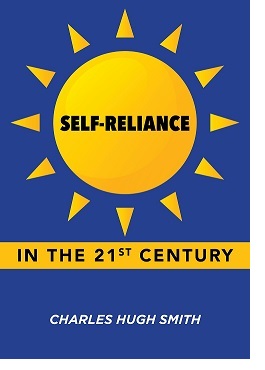Time to Get Out of Dodge?
In my analysis, this is a fatally flawed misreading of structural trends and cycles.
Is it time to get out of the stock market? It depends on the time frame of reference, of course. The market excels at throwing
Bulls and Bears alike off the bus with counter-trend rallies and cliff-dives, so the short-term answer may be different from the weekly
answer or the monthly answer.
So let's stipulate a longer time frame of quarters or even years: is it time to get out of the stock market?
There's a solid case for the answer being "yes." There are two primary dynamics in play: 1) the end of hyper-financialization
and hyper-globalization, both of which drove speculation and goosed profits for decades, and 2) the end of central-bank free money for
financiers, i.e. ZIRP (zero interest rate policy) a.k.a. historically low cost of capital.
The bullish case for stocks and bonds boils down to this one claim: the Federal Reserve will have to "pivot" from raising rates
and reducing financial liquidity free money for financiers to reducing rates and "printing" money again
(increasing liquidity).
This claim is based on two assumptions:
1) inflation was driven solely by Covid-lockdown stimulus and supply-chain disruptions, and these are dissipating. Inflation will
drop dramatically going forward, so the Fed can "pivot" away from fighting inflation.
2) The 2020s are a continuation of the Bull Market that started in 1981, a multi-decade era in which Big Tech leads the market
ever higher, and low interest rates, low inflation, low commodity prices, hyper-financialization and hyper-globalization drive stable
growth of credit, consumption and profits.
In my view, both assumptions are false.
The trend / cycle has turned, and inflation is systemic due to structural scarcities / depletion, the higher costs of reshoring,
friend-shoring, re-industrializing, etc., and the decline of globalization's deflationary impulse: there are no more pools of
cheap labor and materials that can be readily exploited.
The Fed has very little control of these structural sources of systemically higher costs. Their only lever of control is to increase
the cost of capital / credit, which adds an inflationary source to the other structural sources.
As I've endeavored to explain, no cycle or trend lasts forever, and the 40-year uptrend has ended. Now a different cycle and trend
is developing.
The basic reason is diminishing returns: a little credit injected into a credit-starved economy can have a dramatic impact on growth
and prosperity.
But shoving more credit into a debt-saturated economy will have no positive effect at all. Rather, since all debt accrues interest,
it has a negative effect by reducing disposable income via bigger interest payments.
Introducing some globalization (competition and new products) into a stagnant, sclerotic economy can boost growth and prosperity,
but pushing hyper-globalization in an economy already hollowed out by globalization won't have any positive effect at all.
That's where we are: the status quo "solutions" remain financialization (The Fed Will Save Us) and globalization (find a cheaper pool of labor
to exploit and a no-environmental-standards place to stripmine the Earth).
Due to diminishing returns, financialization and globalization are now problems, not solutions. We can't indebt / exploit
our way out of the holes dug by financialization and globalization.
The Bear case is based on the fundamentals of a slowing global economy that can't be saved by increasing financialization and globalization
and the impacts of higher costs due to scarcities, depletion, higher costs of capital and de-globalization / reshoring.
The 40-year long Bull market was based on costs continually dropping due to technology, financialization (declining interest rates and
ever-expanding credit and money supply), globalization, and expanding workforces, production and consumption.
These trends have reversed. Costs are rising, technology is no longer leading growth, globalization is ebbing, workforces are
shrinking and consumption is constrained by scarcities, depletion and higher costs.
The status quo (growth at any cost) has no solutions. Its "solutions" (doing more of what's failed) only exacerbate The
End of Growth. (But trading carbon credits will save us by skimming billions in profits from a shrinking economy! Uh, yeah, sure.)
The Bear case also has a technical-analysis facet.
Many analysts have noted discrepancies in various financial indicators. For example, the VIX is the "fear indicator," and it hasn't
spiked to levels that reflect capitulation / liquidation--i.e., a tradeable bottom.
Sentiment is supposedly bearish but few have actually sold.
Speculative fever is still running hot. As a friend pointed out, when speculations such as dogecoin (with no utility other
than speculation) are still worth billions of dollars, the collapse of speculative frenzy that marks market bottoms is nowhere in sight.
Consumers have borrowed money to fund their spending as inflation chewed up the purchasing power of their earnings, and this
eventually forces a reduction in spending when they run out of credit and/or more of their income is devoted to higher interest payments.
The "money creation machine" of the housing bubble has popped due to the return of mortgage rates to historic norms (6.5% to 7.5%).
Labor shortages due to demographics are pushing wages and benefits higher.
How can companies increase profits as sales slow, costs soar and consumers are tapped out? The short answer is they can't.
Their only response is to lay off workers to reduce costs or in the case of small business, close their doors. This reduces earnings
and consumption.
Other that bloated Big Tech, corporations have already cut their staffing to the bone and hollowed out their training. There's very little
left to trim without eroding functionality and utility. Once those decay, the rot spreads quickly to revenues and then to profits.
A factor that I see as woefully under-appreciated is the End of Speculative Fever. Much of the stock market gains of the past
two decades have flowed not to real improvements in productivity but speculations founded on the recruitment of a "greater fool" to
pay more for an asset than the current owner.
Speculation dependent on extreme leverage and mismatches of duration, liquidity and risk are just as prone to collapse as fraudulent
leverage (cough, FTX, cough).
Once the herd mood shifts from greed / complacency to fear, liquidity dries up and sellers can no longer find buyers.
This was Alan Greenspan's mea culpa after the 2008 Global Financial Meltdown. He admitted the Fed assumed markets would always
remain liquid. But in panics, few are willing to buy on the way down, and those who try are quickly wiped out.
Once buyers get skittish, they vanish. With liquidity gone, markets crash.
Complacency and speculative fever remain firmly in place. The classic signals of a tradeable bottom--a spike in VIX to 90 or 100,
a capitulation that reflects speculative fever has downshifted into fearful caution--have not happened.
That's the fundamental case for exiting the stock market.
The Bullish case rests entirely on the assumption that the Fed can flip a switch and the 40+-year Bull market will resume.
In my analysis, this is a fatally flawed misreading of structural trends and cycles.
This essay was first published as a weekly Musings Report sent exclusively to subscribers and
patrons at the $5/month ($50/year) and higher level. Thank you, patrons and subscribers, for
supporting my work and free website.

 My new book is now available at a 10% discount ($8.95 ebook, $18 print):
Self-Reliance in the 21st Century.
My new book is now available at a 10% discount ($8.95 ebook, $18 print):
Self-Reliance in the 21st Century.
Read the first chapter for free (PDF)
Read excerpts of all three chapters
Podcast with Richard Bonugli: Self Reliance in the 21st Century (43 min)
My recent books:
The Asian Heroine Who Seduced Me
(Novel) print $10.95,
Kindle $6.95
Read an excerpt for free (PDF)
When You Can't Go On: Burnout, Reckoning and Renewal
$18 print, $8.95 Kindle ebook;
audiobook
Read the first section for free (PDF)
Global Crisis, National Renewal: A (Revolutionary) Grand Strategy for the United States
(Kindle $9.95, print $24, audiobook)
Read Chapter One for free (PDF).
A Hacker's Teleology: Sharing the Wealth of Our Shrinking Planet
(Kindle $8.95, print $20,
audiobook $17.46)
Read the first section for free (PDF).
Will You Be Richer or Poorer?: Profit, Power, and AI in a Traumatized World
(Kindle $5, print $10, audiobook)
Read the first section for free (PDF).
The Adventures of the Consulting Philosopher: The Disappearance of Drake (Novel)
$4.95 Kindle, $10.95 print);
read the first chapters
for free (PDF)
Money and Work Unchained $6.95 Kindle, $15 print)
Read the first section for free
Become
a $1/month patron of my work via patreon.com.
NOTE: Contributions/subscriptions are acknowledged in the order received. Your name and email remain confidential and will not be given to any other individual, company or agency.
|
Thank you, Buck W. ($5/month), for your marvelously generous pledge to this site -- I am greatly honored by your support and readership. |
Thank you, Miles H. ($5/month), for your supremely generous pledge to this site -- I am greatly honored by your steadfast support and readership. |


























